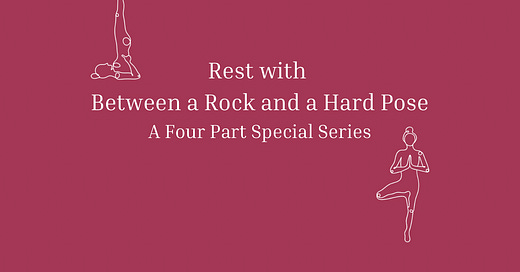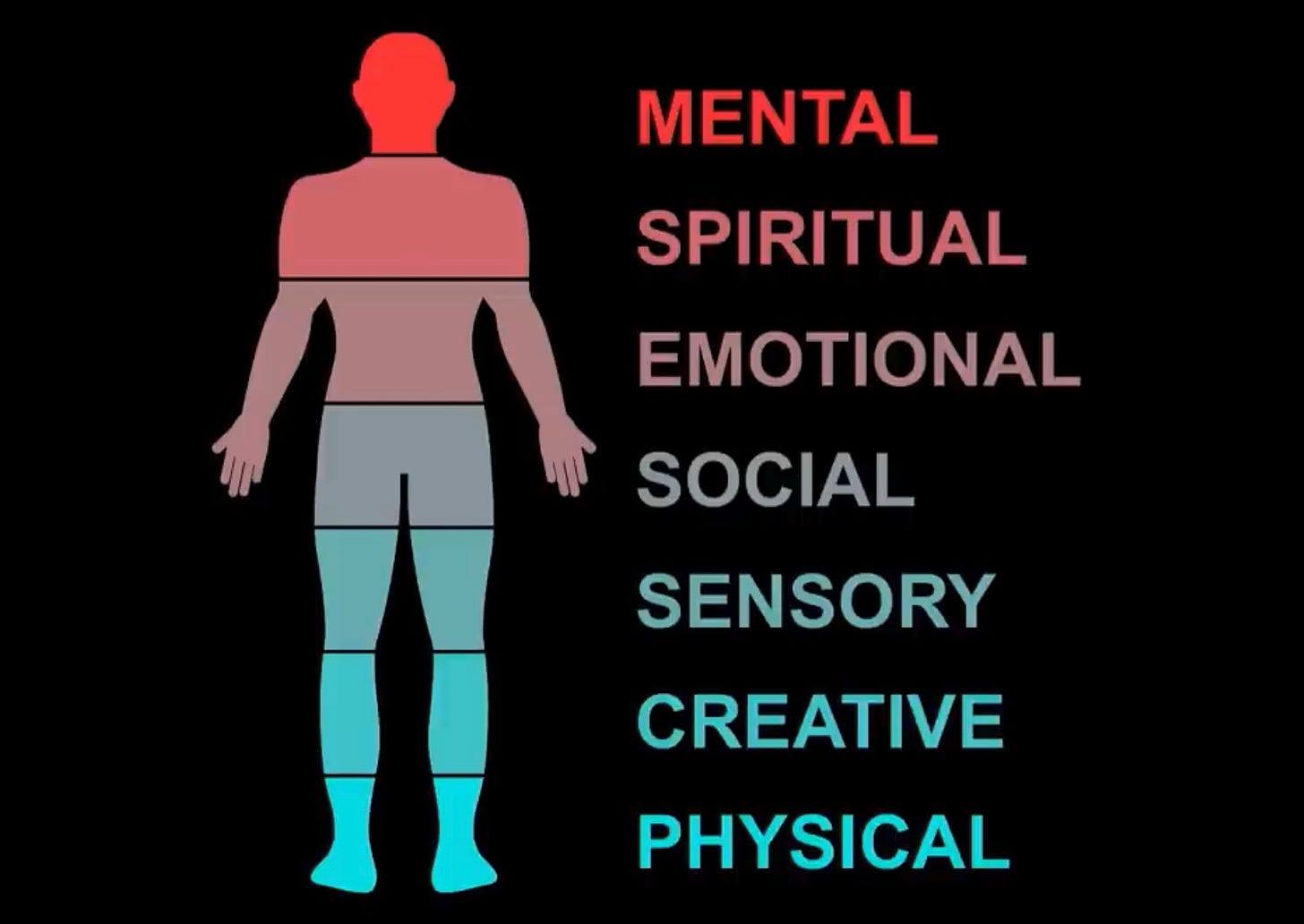Hey there,
This week I am sharing part two of a four part series on rest in collaboration with Dr
, a US based physician and the author of .If you missed last week’s edition of Between a Rock and a Hard Pose, I encourage you to check it out and then come back to read part two.
Part 1: You Probably Have the Wrong Idea About Rest with
Part 2: The 7 Types of Rest with * you are here*
Part 3: A ‘weekday wind down’ yoga class to help you rest with me
Part 4: More examples of the 7 types of rest with me
Ok let’s dive into part two with Jillian!
The 7 Types of Rest
And why even 'extreme' sports like rock climbing count as rest
Hello Between a Rock and a Hard Pose readers!
I’m Dr. Jillian from Humans Leading! Laura invited me to guest post this week, and I’m so glad to be here. I’m a busy physician, mom, coach, speaker, and leader in my organisation, and I experienced burnout twice in my early career. This experience sparked an overhaul of how I do work and life, which I now write and podcast about. I write Humans Leading for high achieving, exhausted professionals who are looking to step out of the hustle in order to live less stressed, more fulfilling lives. In this four part series Laura and I are sharing about a key wellbeing practice that people often get wrong: Rest.
Last week I left you thinking about the price you pay for not taking the time to rest. This week I’m sharing with you the seven kinds of rest with practical examples of each.
As Dr. Saundra Dalton-Smith wrote about in her book ‘Sacred Rest’ and discussed in her TEDx talk, there are seven different types of rest that we need: Mental, Spiritual, Emotional, Social, Sensory, Creative, and Physical.
We can have deficits in each of these areas which need different types of rest in order to address them.
For example, sleep is a type of passive physical rest that is incredibly important. However, if you’re already getting 7-8 hours of sleep a night and are still feeling exhausted (or your sleep quality is terrible), you may have a rest deficit in a different area that needs to be addressed. Or, you may have a medical condition that needs attention. Be sure to address your exhaustion with your primary care physician (GP for the Aussies reading) as you also explore the other areas of rest.
With that medical disclaimer out of the way, we’ll briefly explore these areas in more detail.
Seven Types of Rest:
Physical
Passive - this is where sleeping and lying down come in.
If you’re not getting enough sleep, finding ways to get more (possibly through napping) is important. As my family can attest to, I love a nap. It’s probably because I often have a sleep deficit related to my overnight shifts, and my body loves the opportunity to recharge when it can.
As a mom of a toddler, I understand that getting the recommended amount of sleep is not always possible with young children and will spare you the ‘sleep when the baby sleeps’ nonsense.
As a physician, I understand that our work or home lives may result in us missing an entire night (or much of the night) of sleep. This makes it key to optimize your daytime sleeping after your shift (or before it): eye mask, blackout curtains, sound machine, phone on silent, etc. As I get older, it’s harder for me to fall asleep after an overnight shift because my brain is racing. So, I’ve turned to sleep stories via the Calm app to help. You’ll have to find what works for you.
Lying down and truly resting our minds and bodies is also restorative. But it requires unplugging from the devices that we often find ourselves attached to. The next time you’re looking to do this, put your phone away and pay attention to how different it feels than when you are scrolling or answering emails while you “rest”.
Active - this involves moving your body in restorative ways
This is why Laura’s newsletter and your community here are SO important.
Acive rest allows you to maintain or regain mobility, abut don’t require you to deplete your body of energy.
When you need active physical rest, don’t look for a HIIT workout. Pick something else like yoga, stretching, recovery walks, biking, swimming, hiking, or even rock climbing which also give you the opportunity to connect with nature.
Mental
Your brain needs a break from all of the hard work that it does each day. Giving it time away from problem-solving is key to keeping it working optimally.
Examples of mental rest:
Stream of consciousness journaling.
Reading - be careful with this one. Fiction might be a great escape, but non-fiction runs the risk of continuing to engage your brain when it’s already tired (It’s me. I’m the problem.).
Watching TV/a movie - be sure to notice if you’re trying to use this as an escape/for numbing rather than as something you are truly enjoying. Sometimes, this can become an unhealthy practice.
Physical activity - this can range from restorative to strenuous based on what your personal needs are. For me, this need varies based on how much stress I’m feeling and how much physical energy I have.
Anything that gets you into a ‘flow’ state of deep engagement: a hobby, creative act, etc. I often find that writing my Substack feels a lot like rest to me when I enjoy what I’m writing.
Emotional
If you’re in a helping profession or are a caregiver (basically… if you’re a human), this domain is key for you because you spend much of your time attending to the emotions of other people and not concentrating on your own. You deserve and need people and places where you are free to express how you are really feeling. This is part of why I stress having processing spaces in our workplaces or a solid friend group to rely on.
You can get this kind of rest by being honest about what you’re feeling. Instead of answering “fine” when people ask how you are, find people you can really let your guard down with. Or, pay a professional to listen to your feelings and help you process. Or, if you’re more of an internal processor, journal about them, but don’t judge yourself for being human as you express the feelings.
Social
This type of rest is closely tied to emotional rest. Relationships with other people are key to our wellness and longevity.
However, we all know that there are people who give us energy and there are people who act like energy vampires who drain and deplete us. It is important to keep track of how your energy level is affected when you are around different people. Being around energy-depleting people when you are already depleted will only make the deficit worse.
Also, be aware of types of social interactions that give you energy (laughing, creating, inspiring, learning, volunteering, etc.) vs. those that deplete your energy (ruminating, complaining, gossiping, etc.). It may be nice to vent briefly with your co-workers, but I’d bet that it doesn’t feel good if that’s all you ever do. Find ways to do both.
Sensory
Our world is full of sensory input- lights, technology alerts, machinery, appliances, etc. We are not built to be constantly interacting with these inputs. Be sure to unplug from them on a regular basis.
I like to combine sensory rest with passive physical rest in the hammock in my backyard. Listening to the birds chirp and all of the other sounds in our neighbourhood is a wonderful contrast to the harsh lighting and alarms of the pediatric ICU where I work.
If you need a break but can’t find quiet outside, I highly recommend some noise-canceling headphones and some white noise. The sound of water or a fire crackling has been shown to induce a relaxation response.
There are apps for this, but YouTube is also full of great immersive experiences. You can type “rain, fireplace, autumn” and find videos to get started. This one is a favourite of mine: Cozy Autumn Cabin Ambience with Crackling Fire Sounds, and Pumpkin Glow | Relaxing Fall Escape (youtube.com).
Creative
Whether you’d label yourself as a ‘creative’ person or not, we all do creative work any time we are problem-solving or doing something for the first time (read: every day of parenting or when we take on a new task at work).
To replenish this energy, we can find moments of awe (in nature, in other people, etc.) or immerse ourselves in creative beauty (music, paintings, photography, etc.). We might also become the ‘creators’- using our own creativity to replenish ourselves (and allow for mental rest in the process).
Spiritual
This type of energy relates to accessing something larger than ourselves, but it doesn’t directly relate to religion.
For me, I find connection to other people and the world via meditation and awe-walks in nature (going out and appreciating the natural world by really paying attention to it). For other people, they find this through prayer. However you do this, research shows that it is good for you and your wellbeing.
If you’re ready to find some restoration and you have an achiever personality, you may be tempted to try to hack all seven types of rest at once. However, this strategy is not likely to be successful or sustainable.
Instead, I suggest taking this rest quiz by Dr. Dalton-Smith to find out what type of rest you might need to prioritise now. Then, look back through the list above to identify how you can get it for yourself.
If you’re looking for more resources, this podcast episode is great.
How will you prioritise rest today and throughout the week?
I’d love to hear in the comments, and I’d love to see you over at Humans Leading where I write about topics like this each week.
Upcoming Yoga Classes
Have you joined me for a class at Jeeva yet? New students can currently access a special discount on the new student intro pass. For only $20 enjoy unlimited yoga for 2 weeks, usually $35!
During October and November my classes are focussing on grounding flows, involving plenty of poses for your hips, extra breathwork and lingering in seated folds.











This was a great reminder to myself to take some sensory rest today. Between working in the hospital all week and the chaos of the news/social media, my body really needed to disconnect and get outside today.